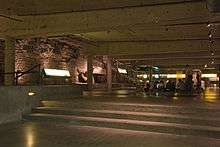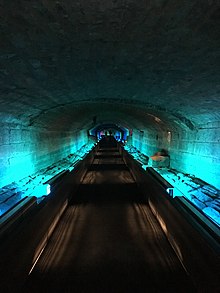Pointe-à-Callière Museum
Pointe-à-Callière Museum is a museum of archaeology and history in Old Montreal, Quebec, Canada. It was founded in 1992 as part of celebrations to mark Montreal's 350th birthday. The museum has collections of artefacts from the First Nations of the Montreal region that illustrate how various cultures coexisted and interacted, and how the French and British regimes influenced the history of this territory over the years. Pointe-à-Callière has been included in National Historic Sites of Canada since 1998.
Pointe-à-Callière, Musée d'archéologie et d'histoire de Montréal | |
 View of the Pointe-à-Callière complex | |
 Location of Pointe-à-Callière Museum in Montreal | |
| Established | 1992 |
|---|---|
| Location | Old Montreal, Ville-Marie, Montreal, Quebec, Canada |
| Coordinates | 45.5026°N 73.5542°W |
| Type | Archaeology and History museum |
| Visitors | 353,503 (2011)[1] |
| Director | Francine Lelièvre |
| Architect | Dan Hanganu[2] |
| Public transit access | |
| Website | www |
It receives more than 350,000 visitors a year.[1] Nearly 4.5 million people have come to the museum since it opened in 1992. It has received more than fifty national and international awards, including those in museography, architecture, and for cultural, educational and community activities. [3] The museum is affiliated with: the Canadian Museums Association, the Canadian Heritage Information Network, and the Virtual Museum of Canada.
The museum complex comprises three archaeological sites: Pointe-à-Callière, Place Royale and 214 Place d'Youville; the archaeological field school at Fort Ville-Marie; Montreal's first Catholic cemetery; the William collector sewer; an archaeological crypt: Place Royale; a heritage building: the former Youville Pumping Station; 165-169 Place d’Youville, the Mariners House; and archaeological collections of over a million objects.
History
The Pointe-à-Callière, Montréal Archaeology and History Complex opened in 1992.[4] The original plan had been to open up the William collector sewer and the remains of St. Anne's Market and the Parliament of the United Province of Canada. Recent archaeological digs brought to light the remains of Fort Ville-Marie and of Governor Louis-Hector de Callière’s home, which are planned for display in a future expansion to expose the Little Saint-Pierre River canalized by the William sewer, and the archaeological remains of St. Anne's Market, home to the Parliament of the United Province of Canada between 1844 and 1849. Visitors will be led to a new exhibition hall, with its entrance on McGill Street, for future international exhibitions on ancient civilizations and their cultures.
In 1996 the museum held its first travelling exhibition, Water In, Waste Out, presented at the Musée de la civilisation (Quebec City) and the Musée et sites archéologiques Saint-Romain-en-Gal (Vienne, France). In 1997, at the Art and Archaeology exhibition 20 Montreal high school students were able to exhibit their works at the Musée et sites archéologiques Saint-Romain-en-Gal. 1690: The Siege of Québec... The Story of a Sunken Ship has travelled to different locations in Quebec and internationally since 2000. France / New France. Birth of a French People in North America, which has already been presented in the Maritimes, toured internationally. The museum also has an exhibition on underground Montreal as part of a cultural route in the underground pedestrian corridors of the Quartier international de Montréal.
Museum complex

The Pointe-à-Callière stands above several historic and archaeological sites of national significance, showcasing major periods in the history of Montreal. Some of the archaeology exposed during construction of the building has been left in situ as part of the museum's permanent display on the history of the city. The museum was constructed on pilings to leave existing finds undisturbed and protected.
The main entrance of the museum rises above the point of land where Paul de Chomedey, Sieur de Maisonneuve, Jeanne Mance and other French settlers landed in 1642.[5]
Complex components
- the Éperon building
- Old Custom House - built in 1836
Exhibits

The museum displays archaeological remains from every period in the city's past, and the sites it protects have produced one of the largest archaeological collections in Canada. The museum's staff specialise in research, conservation, outreach activities and managing archaeology and history. In partnership with universities, it conducts research on the city's archaeology and history, and its ethnohistorical collections include artifacts and documents donated locally. The museum also displays exhibits on the city's built and industrial heritage.
Permanent exhibitions include 1701 - The Great Peace of Montréal, Archaeo-Adventure, Building Montréal, Crossroads Montréal, Memory Collector, Pirates or privateers?, Where Montréal Began, and Yours Truly, Montréal multimedia show.

Along with its permanent exhibitions, since it opened the museum has presented more than thirty temporary exhibitions on themes relating to local and international archaeology, history and heritage, culture and artistic creativity, and multiculturalism. Education and outreach programs and cultural activities are available for school groups and the general public on other aspects of archaeology and history. The museum also hosts musical performances, theatre and demonstrations, including lectures, debates and participation in Montreal, Quebec, cross-Canada and international events. The museum works with Native and cultural communities. For ceremonies commemorating the 300th anniversary of the 1701 Great Peace of Montreal in 2001, the museum’s main partners were aboriginal groups from Quebec, the rest of Canada and the United States.
Temporary exhibitions
- 2014-2015
- The Greeks: Agamemnon to Alexander the Great[6]
- 2014
- Marco Polo: an epic Journey[7]
- 2013-2014
- Lives and Times of the Plateau
- The Beatles in Montréal[8]
- 2013
- The Tea Road
- 2012-2013
- Samurai: The Prestigious Collection of Richard Béliveau
- 2012
- The Etruscans: An Ancient Italian Civilization
- 2011-2012
- Colors of India
- 2011
- To Your Health, Cesar! Wine with the Gauls
- 2010-2011
- St.Catherine Street makes the Headlines
- 2010
- Easter Island: An Epic Voyage
- 100 years underground
- Discovering legends with Jean-Claude Dupont
- 2009-2010
- Pirates, Privateers and Freebooters;2008-2009
- Costa-Rica: Land of wonders!
- 2008
- France, New France: birth of a French people in North America'
- 2007-2008
- 1837•1837, Rebellions, Patriotes vs Loyalists
- 2007
- First Nations, French Royal Collections
- 2006-2007
- St. Lawrence Iroquoians, Corn People
- 2006
- Japan
- 2005-2006
- Jules Verne, Writing the Sea
- 2005
- Encounters in Roman Gaul
- 2004-2005
- Old Montréal in a New Light
- 2004
- Oceania
- 2003-2004
- Dreams and Realities Along the Lachine Canal
- 2003
- Archaeology and the Bible – From King David to the Dead Sea Scrolls
- 2002-2003
- Varna – World's First Gold, Ancient Secrets
- A Collection from the Varna Museum, Bulgaria
- 2002
- Saint-Laurent, Montréal's "Main”
- 2001–2002
- Mysteries of the Moche of Peru
- 2001
- 1701 – The Great Peace of Montréal
- 2000–2001
- Africa Musica!
- Exploring a Collection from the Museo Pigorini
- 2000
- 1690: The Siege of Québec... The Story of a Sunken Ship
- 1999–2000
- Treasures from the South of Italy — Basilicata, Land of Light
- 1999
- Montréal, by Bridge and Crossing
- 1998–1999
- Art and Archaeology: Young Artists from Lyon at the Museum
- Treasures from the Ukrainian Steppes
- 1998
- The Ravages of Time: Restoring Heritage Objects from France
- Crucifixion: Unique Archaeological Evidence from Jerusalem
- 1997–1998
- Bannock, Baguette, Bagel – Montréal Bread
- 1997
- Abitibiwinni, 6,000 Years of History
- Art and Archaeology
- 1996–1997
- Ancient Cyprus: 8,000 Years of Civilization
- 1996
- Dream Merchants. The Emergence of Cinema in Quebec
- Water In, Waste Out. The History of Aqueducts, Water Mains and Sewers in Montréal
- 1995–1996
- Window Stories
- 1995
- The Port as Seen by Pierre Bourgault, Gilles Vigneault and Helmut Lipsky
- 1994–1995
- Bones and Bottles — Fragments of History
See also
References
- "Bilan 2011" (PDF). Tourisme Montréal. Archived from the original (PDF) on 3 February 2014. Retrieved 24 May 2013.
- Canada: Modern Architectures in History
- "Awards and Distinctions", Pointe-à-Callière Museum
- "Pointe-à-Callière, Montréal Archaeology and History Complex", Board of Montréal Museum Directors Archived 2015-05-18 at the Wayback Machine
- "Pointe-à-Callière and Place Royale", Vieux Montreal, City of Montréal
- Pohl, John. "Visual Arts: Ancient Greek treasures at Pointe-à-Callière museum", Montreal Gazette, December 9, 2014
- Lowrie, Morgan. "Marco Polo exhibit at Pointe-à-Callière",Montreal Families
- "Beatles in Montréal 1964 – Exhibition at Pointe-à-Callière Museum", Suites Culturelles, August 5, 2013